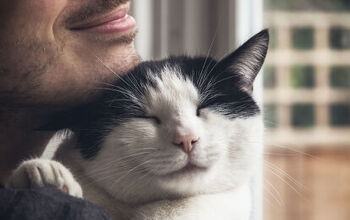Seeing Cross-Eyed: What is Strabismus in Dogs?

Have you ever seen a dog whose eyes seem to point in different directions? If so, it was probably a case of strabismus, commonly referred to as walleye or cross eye. This condition can occur in one or both eyes for affected dogs and it can sometimes be an indication of an underlying problem. Let’s take a closer look at strabismus in dogs.
What Does Strabismus In Dogs Look Like?
We may call it cross-eyed, but really? For strabismus in dogs, their eyes looking in different directions is truly the only symptom. You may notice he’s struggling more as he tries to coordinate movement, or when he’s trying to focus his eyes on the same thing at one time. He may look like he can control one eye but then you’re wondering who he’s looking at with the other.
And it may be in both eyes. If he turns an eye/eyes toward his nose, he’s considered cross-eyed, but if they go away from his nose, it’s considered divergent strabismus. It leads to a lack of focus in eyes and eye muscles, and just like in humans, this may make him more tired or prone to behavior issues.
A lot of times though, even if you don’t see it, your dog may be suffering in with his vestibular system too. This can actually be a cause of strabismus.
The main job of our vestibular system, and that of a dog’s, is to promote balance. If he can’t maintain his balance, he may move his body to try and compensate. His eyes will move abnormally as he’s trying to adjust, and this can build poor eye muscles and convergence.
What Causes Strabismus in Dogs?
The term “strabismus” refers to the abnormal positioning or direction of a dog’s eyeball. In healthy dogs, the eye is held in place by small muscles that are attached directly to the eye. By contracting these muscles, the dog can move the eye from side to side and up and down. If one of the muscles supporting the eye becomes stronger or longer than the muscle in the other eye, it can cause the eye to move in an abnormal direction. This condition can affect one or both eyes and the eyeballs can deviate in any direction. When the deviation moves in toward the nose, the dog is usually said to be cross-eyed.
Related: Living Well With Your Blind Dog
When it comes to the cause of strabismus in dogs, there are a number of different possibilities. For some dogs, strabismus is a genetically inherited condition – this is particularly true for Boston Terriers and Pugs. Another major cause for this condition is injury or trauma to the eye which results in scar tissue or inflammation that restricts the movement of the eye or affects the supporting muscles. In rare cases, the visual fibers in the central nervous system become crossed which leads to abnormal deviations in one or both eyes. In order to diagnose your dog with strabismus, your vet will need a thorough medical history and a description of symptoms – he may also need to perform an eye exam, x-rays, and other tests to determine the underlying cause for the condition.
Treatment Options and Prognosis
The treatment options for strabismus in dogs depend on the underlying cause of the condition. In dogs where the condition is genetic, treatment is generally not required because the condition is primarily cosmetic in nature – it doesn’t affect the dog’s ability to see and it doesn’t cause him any pain. In cases where the condition is caused by inflammation or scar tissue, surgery may be required to correct the condition. In some cases, anti-inflammatory medications may be enough to correct the issue and the dog might need some therapy as well to help strengthen the muscles behind the eye.
Related: What is a Double Merle Dog?
Depending on the type of treatment your dog receives, the prognosis for strabismus is generally good. Your veterinarian will want to see your dog for at least one follow-up visit after the treatment to make sure he is healing and recovering properly. If your dog’s strabismus is due to some kind of infection, you may need to take him in for check-ups more often and you should keep an eye out for side effects caused by antibiotics or other medications. If during your dog’s recovery you see any signs of the condition returning, contact your vet immediately in order to prevent permanent damage happening to your dog’s eye.
In many cases, strabismus is not a painful or dangerous condition for dogs – especially in cases where it is an inherited genetic disease. If the disease is genetic it is not recommended that you breed your dog because he could pass it on. If your vet decides that treatment is not necessary you may need to make some accommodations for your dog if the condition affects his vision, but most dogs do just fine.
Often, vets will recommend tracking exercises for your dog. These involve your dog following your fingers (much like vision therapy for humans) and working their eye muscles to converge appropriately. In some cases, these exercises can help the appearance of the eye divergence as well as the processing your dog has to do when seeing.
Common Accommodations for Dogs with Vision Problems
If your dog is struggling with vision problems due to strabismus, there are a few small changes you can make in your home and your daily routine to help him adjust and function as normally as possible. The degree of accommodation required will depend on how severe your dog’s vision problems are. Start small, giving your dog time to get used to each change that you have made. At the same time, watch how he responds as this will help you recognize if additional changes are needed.
- Avoid changing the location of furniture or important items like your dog’s food and water dishes. He will learn where these items are located in the home without having to rely entirely on his vision, which is a skill that can help in the future as well if his vision problems do progress. Consider placing an adhesive star or dot on the floor directly beneath your dog’s dishes so that you can move them for cleaning, returning the dishes to the exact location after.
- While walking your dog, try to be more patient of sniffing and exploring. One of the main ways that dogs navigate the world around them is through scent. If your dog is experiencing any degree of vision loss, they may rely on this even more.
- Keep potential tripping hazards up and off the floor as much as possible. This includes loose shoes, laundry baskets, toys, or any other item your dog may trip over if he doesn’t see it. You should also do your best to tuck electrical cords away where your dog can’t get tangled up in them.
- Pad any sharp corners on your furniture, such as the corners of your coffee table. One of the first vision-related issues that dogs often experience is with depth-perception, meaning that your dog may not recognize how close to or far away from an object he is. Exposed sharp corners could lead to avoidable accidents and injuries.
- Try to avoid picking your dog up or carrying him around too much. Your dog is going to start navigating the world around him more using scent, sound, and his own internal compass. When you pick up or move your dog, you can easily disorient him after he has been put back down again. If you do have to pick him up for any reason, try to place him back where you picked him up, facing in the same direction.
- Put up barriers where needed to prevent tripping and falling. If you have stairs, your dog may be able to navigate them fine most days. However, it only takes a misstep once to cause an accident. Your dog should only have access to potentially dangerous areas like stairways and balconies under direct supervision to keep him safe.
Whatever you do, remember that your dog feeds off your energy. If you are highly stressed, your dog will be as well. Try to remain calm and patient, focusing instead on the ways you can help. Don’t forget that this doesn’t impact your relationship. Your dog will still find comfort in your voice and affection.

Kate Barrington is the loving owner of two cats (Bagel and Munchkin) and a noisy herd of guinea pigs. Having grown up with golden retrievers, Kate has a great deal of experience with dogs but labels herself a lover of all pets. Having received a Bachelor's degree in English, Kate has combined her love for pets and her passion for writing to create her own freelance writing business, specializing in the pet niche.
More by Kate Barrington






















